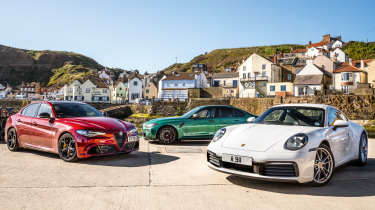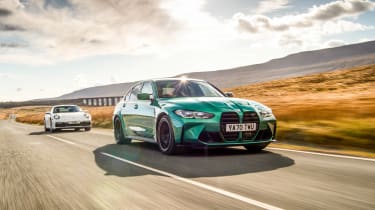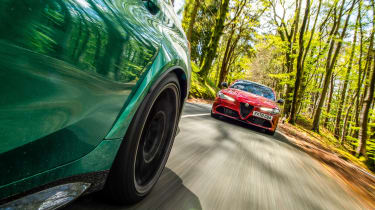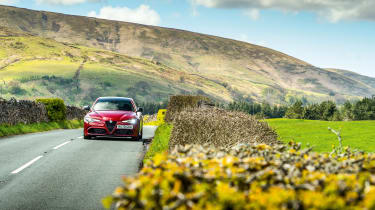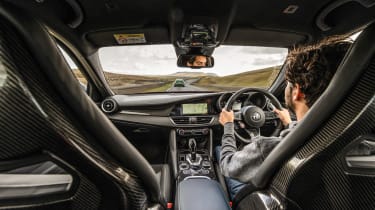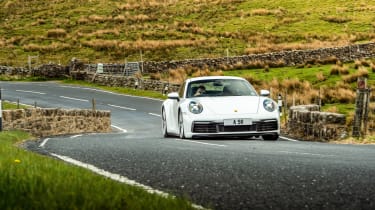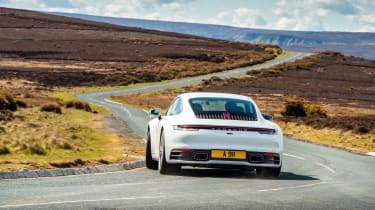BMW M3 Competition v Alfa Romeo Giulia Quadrifoglio v Porsche 911 Carrera
It’s M3 Competition versus Alfa Giulia Quadrifoglio in the battle of the sports saloons, and just to really test their mettle, we’ve brought along a 992 Carrera, too
Beauty and the beast. It’s a tempting if lazy way to polarise our pair of 500bhp sports saloons, but I promise that’s the first and last time I’m going to make reference to the BMW’s bizarre nostrils. Instead, I’m more concerned about the amount of pies it appears to have been consuming, and the switch to a torque converter automatic gearbox from the old M DCT. Is it really going to cut it as a proper M3? These are the questions we’ve set out to answer over the course of a couple of days’ driving.
I claim first dibs on the M3, which is how I come to be slogging up the M6 early on day one. Somewhere out there Dickie Meaden is making similar progress in our evo Fast Fleet Alfa Romeo Giulia Quadrifoglio, while Jordan Katsianis is similarly watching the miles tick by from behind the wheel of a plain vanilla Porsche 911 Carrera. The Alfa’s presence here is easy to understand: it’s our favourite sports saloon of the moment, so it’s an obvious and formidable foe for the new M-car – a straight shoot-out for class supremacy. We could have added a Mercedes-AMG C63 to the mix, but that car isn’t long for this world, so you can find our musings on the model’s future at the end of this story, in the form of the CLA45. There’s an Audi RS4 back there too, demoted on account of it being significantly outgunned in this company and, with the arrival soon of the M3 Touring, about to lose a precious USP against the BMW.
> 2022 BMW M3 Touring shown partially undisguised
But the 911? That’s a slightly more esoteric comparison. The standard 911 has always been just one tantalising step up from the BMW, a barometer of excellence in semi-attainable performance motoring, whether a 993 Carrera over an E36 M3, or a 997 above an E46. But in this test the heavily optioned M3 retails at £86,745, up from a basic price of £74,755, while – unusually for a press car – this 992 Carrera has limited options and hence costs £86,290, up from £84,870. The Alfa is more affordable than either at £67,195 basic, but again options bring it close at £83,295.
BMW M3 Competition
You certainly get a lot of BMW for your money, the G80 M3 having a chubby kerb weight of 1730kg, a rise of 170kg over the old F80. The 992 Carrera is heavier than its predecessor too, by 75kg over the 991.2, largely due to the adoption of the hybrid-ready eight-speed PDK gearbox as standard and the ‘wide’ body for all variants. It still undercuts the M3 significantly, though, tipping the scales at a more respectable 1505kg. The Alfa sits almost exactly halfway between the other two with a figure of 1620kg.
You can tell a lot about the new M3 from the first mile, but even before it turns a wheel, the solidity, complexity and consciously ‘designed’ ambience of the interior are a strong clue to the BMW’s personality. The driving position is a low, well-sited one, and the support from the carbon buckets seats is substantial. But it’s once you’ve fired the S58 straight-six into life and engaged Drive on the central shifter that you really get the M3’s flavour. The car itself feels immensely rigid, left to right and diagonally, as if it’s being braced by a welded-in FIA cage. The ride quality, even in the softest setting the car always defaults to, is overtly firm, but as the first sunken manhole cover and road scars are dealt with, it’s also clear that the M3 has quite outstanding wheel control and poise. Even at low speed, when the onset of a ridge or awkward hole looks sure to punish those 35-profile rear sidewalls, the car deals with them via one sharp but beautifully controlled motion. Substantial miles are shrunk effectively in this car, despite its sporting aspirations.
The S58 engine is markedly different to the old S55: still with the same underlying gruff straight-six bark, but more rounded, with less of that raucous metallic twang and virtually no suggestion of it being turbocharged. It pulls from almost zero revs convincingly, its delivery strikingly linear, and while there’s a sports exhaust option, the GPF ensures that a few burbles on the overrun and a subdued boom is all you’ll hear from the outside. When you factor in the oily smooth changes of the torque converter, you have a car that manages to feel both quietly potent, and indeed special, but also completely undemanding and effortless to spend time in. Not an easy trick to get right.
Having filled our steeds with superunleaded at our designated meeting point, it’s time to head off into the Trough of Bowland and its narrow lanes. I’ve set the BMW’s mode paddles to a fast road mix – M1 with the MDM traction setting for fun with some inherent security, and M2 with the most aggressive engine, medium suspension still (Sport Plus is too aggressive for the road) and no traction or stability net whatsoever – so I can switch between the two as I see fit.
I’m following in the tracks of the 911 and it looks wide. In fact it’s only 44mm wider than a 991 or a 997, but it’s 87mm wider than an original 996 Carrera. Then again, the new M3 dwarfs an E36 or E46 M3. The reality is that the Cayman now occupies the space the 911 once dominated, leaving Porsche’s icon to fulfil a wider remit than ever before.
More of a ‘sports coupe’ it may be these days, but the 911 is already giving notice that it remains the sports car of this trio, because I can see Jordan is able to thread it down this hillside sequence of random curves with the kind of confidence and point-and-squirt pace that is uncomfortably brisk from within the wider, loftier M3. That’s not to say the M3 isn’t effective, far from it, just that its size, weight and saloon car foundations eventually show.
On the plus side, that sense of titanium-cored strength at lower speeds translates to fabulous body control when you’re really pushing on. The M3 just never feels like it’s out of its comfort zone. There are some wicked sudden compressions on the road we eventually reach, with gouges running deep through them to attest painful prior car-road interfaces, but the M3 is never going to be caught out by them. The harder you drive it, the more you lean on the brilliant brakes into a corner, relishing the calm progression of the steering, the more the inherent balance of the M3 seems to bubble up to the surface. The old F80 could feel pretty wild at times – even the improved later cars – but the G80 feels completely on your side, adopting a deliciously neutral ‘set’ into a corner and often embellishing the sensations with small, controlled amounts of oversteer on the way out. Be more liberal with the throttle out of a tighter corner and it’ll really light up the rear, the diff more predictable in its responses than the sometimes hard-to-read unit in the Alfa.
When we stop for a chat and a swapover, Dickie – who had seemed cool towards the M3 initially – is very much a fan: ‘It’s a great feeling, playing with the poise and the balance. If there was a cresting corner you’d know it’s going to relax on its springs a little bit, and then it might slide, but precisely and predictably. Almost in a way that you don’t have to think about. Just enough, though, to be fully engaged, but not edgy enough that you’re actually more consumed by the jeopardy than you are by the fun. For a car as big and with the mass that this thing has, I think it’s really impressive.’
Alfa Romeo Giulia Quadrifoglio
Time to reacquaint myself with the Alfa. Sitting in its £3250 Sparco carbon buckets, the driving position is even better than the M3’s, and the ambience utterly different to the German. After the airy, techy feel of the Beemer, the Alfa’s snug, chummy cockpit with its narrower glasshouse and dark materials, its simpler switchgear and screens, and the raucous growl of the 2.9-litre V6 all combine to strike a completely different chord.
If there’s one thing that’s becoming abundantly clear, it is that here we have two terrific sports saloons that come at the same objective from entirely different parishes. What makes it all the more surprising is that they’re both powered by turbocharged six-cylinder engines developing 503bhp, have torque converter automatic gearboxes and rear-wheel drive, and yet in strengths, weaknesses and character they genuinely couldn’t be more different. I cherish the fact that in 2021, with the world increasingly homogenised, here are two cars that have such strong, unique flavours.
At one end of the spectrum, the Alfa’s almost lazy spring-rates and soft damper settings in comfort mode make it a wonderfully relaxing car to pad around in. There’s a fluidity to it that has become extinct in German performance cars, one that apes the Alpine A110 in how it relaxes and goes with the flow – a quality that often seems to have a correlation with the driver’s heart rate, too. Having said that, occasionally a nasty pothole has a tremor reverberating through the car, a sense that the suspension is struggling just a little to cope with the weight of a large alloy wheel flung suddenly aloft in a way the M3 would never allow to happen.
I wanted to make the above clear first, and to add that by and large the Quadrifoglio feels like a quality product, inside and out, before getting into what the Alfa is like to really drive, because so much of what follows is going to sound like a nationalistic stereotype that there’s a danger the whole car gets seen through a one-dimensional lens (with its inevitable clichéd negative connotations too). Nevertheless, if you think that a 503bhp Italian sports saloon with a massive cloverleaf slapped on its flanks will be full of passion, verve and spirit, a red-blooded force of nature that’s impossible to deny, then you know what? You’re exactly right.
From the boom and distinctive note out of its Akrapovic exhaust, to the way the V6 wants to rip up the rev range, the Giulia immediately begs to be driven quickly in a way the others just can’t inspire. Those massive aluminium paddles are a masterstroke – if strangely difficult for rivals to emulate it seems – while the shifts themselves seem quicker than the BMW’s, and without the yawning wait if you’ve strayed near the engine’s red line that also afflicts the M-car. The light steering is so fast from lock to lock you have to immediately calm your inputs to avoid unsettling the car, and the rear gently shuffles around as the electronically controlled diff attempts to deploy all that grunt.
It’s an engrossing, invigorating experience. ‘It just has such an abundance of power and torque that it always feels quicker, faster, more accelerative, more muscular than the BMW, and the Porsche for that matter,’ is Dickie’s take, and I can only assume the lighter claimed kerb weight for the Alfa than the M3 plays its part here. By comparison, the BMW offers more torque (479 versus 442lb ft), but sometimes you sense it’s as though the M3 is trying to run around with a heavy rucksack on its back, blunting its initial responses.
Unlike the BMW, the Alfa needs the vertical support from its firmest damper rates for this challenging Dales road, even if they make the ride a little choppy: it’s the only way to protect the underside on the sudden compressions, but it also requires you to select Race and do without any electronic safety net, which certainly focuses the mind. The brakes are powerful, but the initial response is a bit snatchy, denying the sort of flow that characterises the other two cars. At this sort of pace the driver is certainly on high alert in the Alfa, but they are also the one likely to have a huge grin plastered on their face, even if it occasionally switches to a grimace.
Porsche 911 Carrera
Next morning it’s off to the moors and I grab the key to the 911. I miss the old, driver-focused interior with its clearly legible dial pack, but the Carrera retains that low-slung, purposeful environment that 911s do so well and immediately serves up the typical Porsche offering of beautifully balanced control weights and precision to everything it does. The turbocharged 3-litre flat-six is fairly muted in normal driving, and in this 992 there isn’t the suite of modes to wake things up – it’s simply a press of the Sport button and then a switch to toggle to ‘M’ for manual, down where once there used to be a gear selector. The tiny paddles behind the steering wheel are disappointing to use after the Alfa’s (the BMW’s are somewhere between the two), almost to the point where you wonder if Porsche actually wants you to change gear. However, when you do, the PDK shames the responses of the other two, particularly at higher revs.
Evaluating the 911’s straight-line performance is tricky. On one hand its ability to sprint off the line with the benefit of turbo-rich torque and short initial gearing makes it a rocketship, and wrung out and hauling hard up to 7000rpm it feels the quickest car here, but there are other times when just tipping into the throttle seems to have surprisingly little effect, even once a suitable ratio is acquired. Let the auto ’box sort it out and you’ll have a pause followed by a rather graceless snatch while it frantically tries to match gear, revs and a suitable rate of acceleration. Its 380bhp and 332lb ft clearly lag behind the other cars here, but the additional weight of the 992 feels like it is perhaps sometimes taking its toll too, and, odd as it may seem to say it, so does the overall excellence of the car’s fundamental engineering.
Yes, the inconvenient conundrum of the 992, as we’ve said before, is that it’s almost too polished – it’s so good at refining the process of going quickly that somehow something intangible has been lost in the process. In this form it feels like it could so easily take a lot more power, but it seems curiously reticent at times to really give an experience back to the driver unless you’re driving the wheels off it. Meaden says it requires ‘a concerted effort to reveal the 992’s sparkle’, while relative new-boy Jordan seems bemused to the point of being upset that he’s not enjoying it more. I won’t lie, I am too. Unless you’re really placing loads through the chassis it seems to go into a meticulous ECU-regulated doze. It’s a curious thing, and a devil to describe, but as deeply impressive as it is, fun isn’t always at the top of its agenda.
No such qualms in the Alfa. Hacking across the wide open spaces, a flutter of rain bristling against the screen, the Alfa forges on, pulling out a yard or two over the BMW, then losing ground elsewhere, both literally and in our affections. The BMW has the dynamic advantage in the majority of situations, the Alfa the shining drivetrain. Then it rains properly, the temperature drops to 3 degrees, and the sticky Pirelli Corsas go for a long lunch, with many courses, and wine…
The Porsche’s work is done. It’s proved that the old status quo remains solid: it’s the fastest car here, stops and changes direction in a way the other two can only fantasise about, and its traction is on another level. In addition, in this 992 iteration it is the consummate everyday sports coupe, useable to the extreme, enjoyable regardless of your skills behind the wheel. And yet we all agree that the basic 992 feels a poorer car without the power and tech of the more expensive models, a reversal of how 911s often used to feel. It’s a car we admire for many of its attributes, but none of us feel overly passionate about. Strange.
All of which leaves our core protagonists battling to the line. Last time the M3 took on Giulia, the Alfa Romeo took the spoils from the F80 Competition by the narrowest of margins. This time we all eventually agree that the M3 is the better car in an objective sense. When I first walked towards it with key in hand, I admit I felt some resentment at the direction the car has gone in, and yet, miraculously, BMW M has worked an absolute blinder, somehow gelling all the constituent parts into something that works beautifully.
It’s a proper M3, but I wonder if it isn’t almost an even better M5. By which I mean that when an M2 Competition/CS seems spiritually to occupy the spot where the M3 once sat, encapsulating what made previous generations so desirable, so the G80 seems like a modern interpretation of the traditional M5 recipe – involving sports saloon one moment, continent crusher the next. Dimensionally it’s similar to the E39 and E60 M5s, and it’s almost as heavy. With the weight and sheer size of the current ‘real’ M5 making it unsuitable for many UK roads, I’d much rather have a G80.
So that’s all very neat then. Except that this is evo, so… ‘From a professional road tester’s perspective the BMW trumps the Alfa, but as an enthusiast I know that in my heart I love the Giulia,’ says Dickie, glancing fondly at the Giulia, streaked in unseasonal road salt. Jordan calls the big red one ‘joyful’ despite giving the nod to the M3 overall ‘by a hair’.
The appeal of the M3 grows on you, and will probably continue to do so over time, but having the Quadrifoglio in your life is to possess something that feels truly exotic, that makes you feel all warm and fuzzy inside every time you see and hear it, that brings the task of driving for fun truly alive. You’ll always look for the long, interesting way home in the Alfa, in a way you only occasionally would in the others. That’s not just the hallmark of a great car, it’s the stuff of an evo legend.
Specs
| BMW M3 Competition | Alfa Romeo Giulia Quadrifoglio | Porsche 911 Carrera | |
| Engine | In-line 6-cyl, 2979cc, twin-turbo | V6, 2891cc, twin-turbo | Flat-six, 2981cc, twin-turbo |
| Power | 503bhp @ 6250rpm | 503bhp @ 6500rpm | 380bhp @ 6500rpm |
| Torque | 479lb ft @ 2750-5500rpm | 442lb ft @ 2500-5500rpm | 332lb ft @ 1950-5000rpm |
| Weight | 1730kg | 1620kg | 1505kg |
| Power-to-weight | 295bhp/ton | 315bhp/ton | 257bhp/ton |
| 0-62mph | 3.9sec | 3.9sec | 4.2sec |
| Top speed | 155mph (limited) | 191mph | 182mph |
| Basic price | £74,755 | £67,195 | £84,870 |
| As tested | £86,745 | £83,295 | £86,290 |
This story was first featured in issue 287. Browse back issues at the evo shop.

